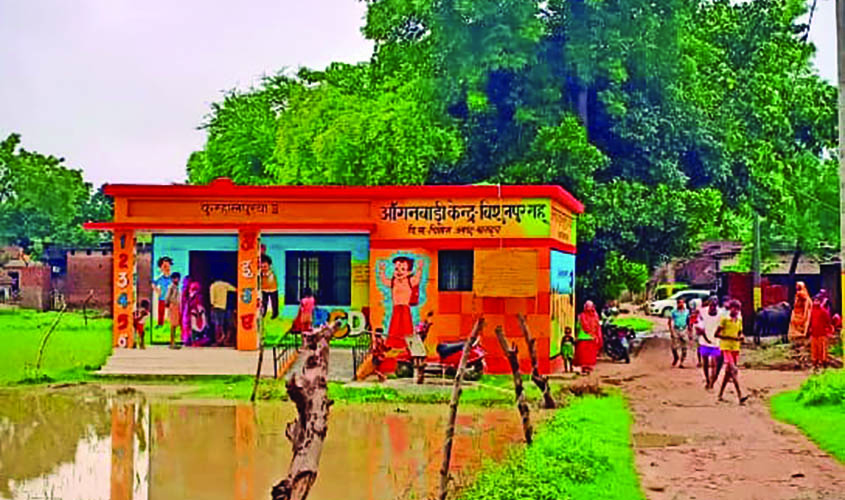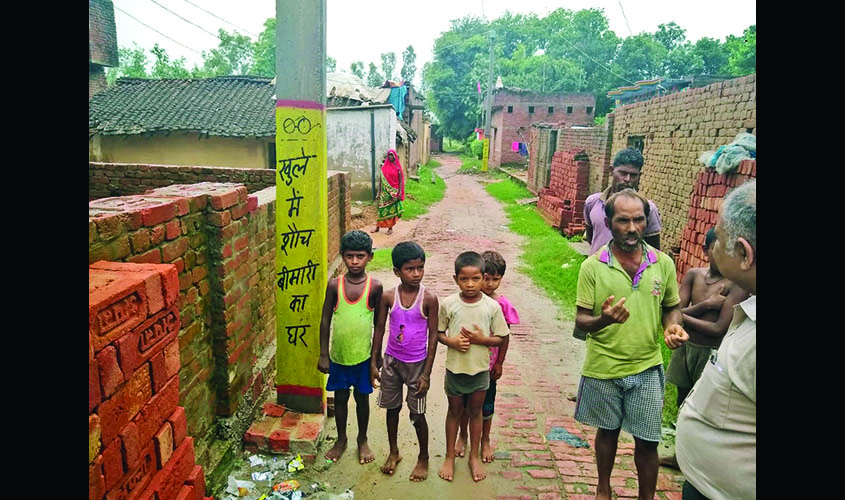Expertise of private professionals is being used for oversight, monitoring of poverty-alleviation programmes.
Bahraich, UP: Seema Devi, an Anganwadi worker, displays packets of daliya to be distributed among children under five years and pregnant women. The Anganwadi, at the Kumharpurva village in UP’s Bahraich district, doubles as a playschool and a health centre offering very basic medical check-ups. “About 20-22 children come here,” she says.
This is the last station of the welfare express, stopping at the bottom of the pyramid. Various other phrases too spring to mind—grinding poverty, the wretched of the earth, teeming millions. The terms we journalists use regularly in our write-ups. But they acquire a tangible reality at Kumharpurva, for Kumharpurva is what these terms look, feel, and smell like; and there is little pleasant about the look, the feel, or the smell—even in the lush green surroundings, made lovely by rains. For the patch of penury has sullied the natural beauty. This is certainly not a rural idyll. Yet, politicians glorify it and cinema glamorises it. The glorification and the glamorisation have been the bane of rural India.
Efforts have been made in the past, though, to improve the situation—often without much success, especially in the poorest of the poor places like Kumharpurva. The private sector has always played an important role in philanthropic activities; government, too, is committed to the concept of welfare state; both have often worked together. But this is perhaps the first time that they are working synergistically. The expertise and competence of private professionals is being used for oversight and monitoring of poverty-alleviation programmes.
The Prime Minister-headed Niti Aayog has come up with the idea of using the skillsets of the private sector rather than their financial resources.
We are on a media junket, jointly organised by the Niti Aayog and the Piramal Foundation, to witness the synergies. “The difference between the earlier approach and the present one is that now we know that somebody in Delhi is watching us, Niti is watching us,” says Shambhu Kumar, District Magistrate, Bahraich. “Now, officers have been made to realise that they are answerable.”
The point is that now their accountability goes beyond the conventional government mechanisms—the vigilance department, inspections, surprise checks, et al. Now, there are private professionals who are working on the ground with the welfare workforce—Anganwadi workers, auxiliary nurse midwife (ANM), etc. And these professionals, not beholden to sarkari deference, have the authority to question government officers as well as oversee the functioning of ground-level workers. Besides, these professionals are regularly in touch with Niti—and the local officers know it.

“Earlier, it was like an orchestra without a conductor,” says Alok Kumar, Adviser, Niti Aayog, who is in-charge of the social sector in backward districts, rechristened as aspirational districts, 117 all over the country. “All the pieces of orchestra were there—funds for various programmes, departments to carry out their respective duties, etc. But there was nobody to do coordination and monitoring.” Private professionals are doing that now.
This has made a difference. “When I began work 18 months ago, the Anganwadi centres were focused mostly on vaccination, and that too didn’t attract many,” says Rupesh Singh, operations head, Piramal Foundation. “But now we have the Village Health Sanitation & Nutrition Day or VHSND which is once a month. It is held for a population of 1,000.”
The Anganwadi worker, the ANM, and the Accredited Social Health Activist or Asha are the three pillars of the programmes aimed at improving education and health. “The accountability of officialdom has increased because of us,” says Anoop Pant, change communication specialist, UP, Piramal. “Action has also become faster.”
This is not to say that the welfare state has found its holy grail. The Anganwadi at the Muslim-dominated village Raipura in the same district is crowded. Like the one at Kumharpurva, this too is small, about 15 by 15 feet, and without electricity connection. “When the temperature goes upwards 45 degrees, it becomes intolerable,” says Ashfaque Ahmad, the block transformation officer, Piramal.
It is pleasant outside because of the intermittent showers. We sit and watch the functioning of the Anganwadi. About a dozen women, many of them in burqa, are sitting on the ground. Apart from the Anganwadi worker, there is also an ANM. An argument ensues between the Anganwadi worker and a local lady about the supply of nutritional food.
There is a very young pregnant girl, perhaps 16 or 17, though her mother insists that she is 19. And very thin, also anaemic. The haemoglobin metre showed 4.9. The local workers and Piramal professionals say that she should be taken to hospital. Another test found the level at 6.2. Everybody decries the quality of the instrument.
The girl is anaemic though; it’s quite visible. Her mother, however, is unwilling to take her to hospital.
Another problem the local workforce faces here is the misinformation in the Muslim community about modern medical facilities. For instance, many believe, as in Pakistan, that vaccination will damage them, especially children bodies. Thankfully, there haven’t been any assaults on health workers, as they happened in Pakistan and Afghanistan. But it hampers our work, Ahmad says.
We come across thin, emaciated men and women, malnourished children in both villages. Which is not surprising, because Bahraich is a backward district, though now labelled as an aspirational district. Aspiration is evident, though, in the concern for education.
The school nearest to Kumharpurva is 3 kilometres away, but young children mostly walk to it. Sushma, who is in the second standard, is one of them. The 15-year-old Arjun Kumar Prajapati studies in Class 9 in a public school and pays a fee of Rs 200-250. Nanku Prajapati, who is 30 but looks at least 40, laments, “Our children want to study and we want also want that but there is no school.”
There are other problems, too. Tilak Ram complains that sometimes full ration is not available. Kamli, widowed five years ago and with three sons and a daughter, is striving to build a pucca house. She takes me to her home and, mistaking me for a government officer, pleads for help. Her eldest son is 13 years old and helps her in the cultivation of some land she owns. I pass on the message to the professionals.
Private professionals do assist the villagers, but there are limitations—of state capacity, administrative proficiency, financial resources, everything. But the professionals are bold enough to complain about erring officials, demand specific interventions, and suggest measures for better results. In fact, even some officials seek their help to get things done.
There are good men and women trying to make things better, to alleviate the sufferings of the poor, but at the heart of the problem is the slow pace of economic development. Industrialisation in Bahraich is limited to four sugar mills, though capacity expansion is on the cards in all of them. Some activity on the tourism front is also beginning, as the district is on a Buddhist circuit.
But economic development doesn’t appear to be the top priority of the local administration; this is not surprising as the Central and state governments are focused on welfarism, keen as they are to bolster their pro-poor image for political considerations. For instance, in our interaction with the District Magistrate, he informs us about the capacity expansion of four sugar mills not on his own but in response to a specific query. He also tells us that he helped a start-up access bank loan by quickly sorting out an administrative issue; the new enterprise has employed 120 youngsters from a local ITI. Such, however, is the grammar of public discourse that he doesn’t even regard such an impressive feat worthy of mention!
In the ultimate analysis, the cure for poverty is economic development. The welfarist measures are at best a palliative for the poor to take care of their immediate worries. The problem is that the powers that be often confuse palliatives and treatments with cure. One hopes that this doesn’t happen in Bahraich.
Ravi Shanker Kapoor is Editor, www.thehinduchronicle.com

